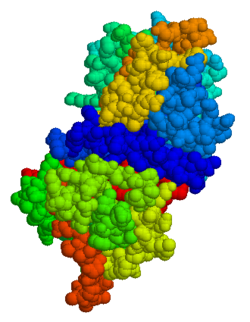C1-inhibitor (C1-inh, C1 esterase inhibitor) is a protease inhibitor belonging to the serpin superfamily.[5] Its main function is the inhibition of the complement system to prevent spontaneous activation but also as the major regulator of the contact system.[6][7]
- ^ a b c GRCh38: Ensembl release 89: ENSG00000149131 – Ensembl, May 2017
- ^ a b c GRCm38: Ensembl release 89: ENSMUSG00000023224 – Ensembl, May 2017
- ^ "Human PubMed Reference:". National Center for Biotechnology Information, U.S. National Library of Medicine.
- ^ "Mouse PubMed Reference:". National Center for Biotechnology Information, U.S. National Library of Medicine.
- ^ Law RH, Zhang Q, McGowan S, Buckle AM, Silverman GA, Wong W, et al. (2006). "An overview of the serpin superfamily". Genome Biology. 7 (5): 216. doi:10.1186/gb-2006-7-5-216. PMC 1779521. PMID 16737556.
{{cite journal}}: CS1 maint: overridden setting (link) - ^ Davis AE (September 2004). "Biological effects of C1 inhibitor". Drug News & Perspectives. 17 (7): 439–46. doi:10.1358/dnp.2004.17.7.863703. PMID 15514703.
- ^ Cicardi M, Zingale L, Zanichelli A, Pappalardo E, Cicardi B (November 2005). "C1 inhibitor: molecular and clinical aspects". Springer Seminars in Immunopathology. 27 (3): 286–98. doi:10.1007/s00281-005-0001-4. PMID 16267649. S2CID 24583403.





